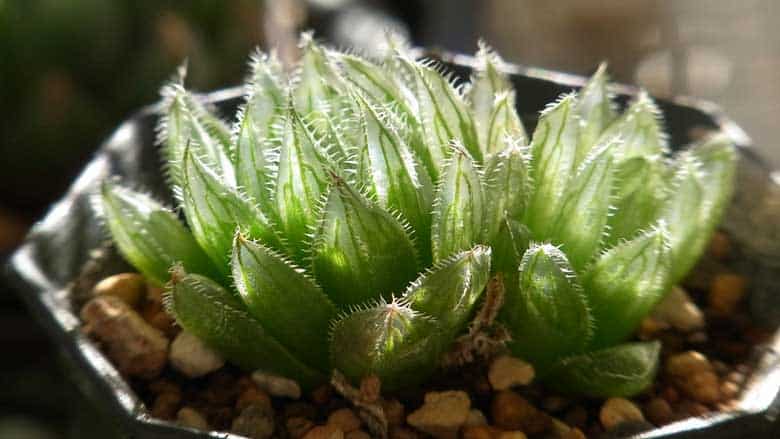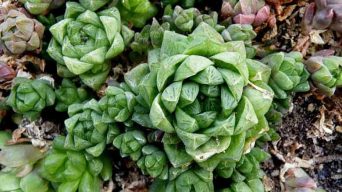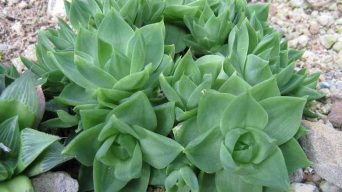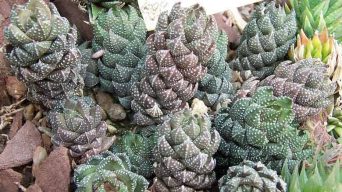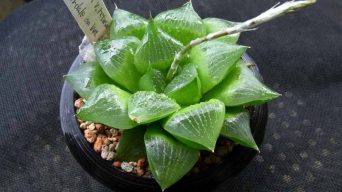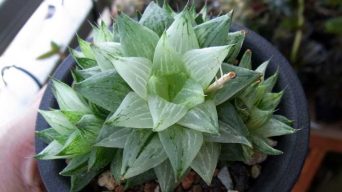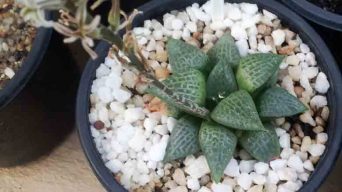The Haworthia plant is a genus of succulent plants that come from the Eastern Cape Province in South Africa.
Haworthia cooperi, also called Cooper’s haworthia or long-leaf haworthia, are small rosettes with pointed translucent leaves and an upright growing stem.
The plant only reaches 12 inches tall when mature, even though it may form clumps up to 24 inches wide as well as spread out about 18 inches in diameter.
This makes them great for pots on tables or desks, which is why they’re so popular among office workers around the world!
These plants are relatively easy to care for and propagate, so they make great houseplants for beginners.
This guide will go over all you need to know about how to take care of your Haworthia cooperi succulent and how to propagate new ones.
How To Care for Haworthia Cooperi
Haworthia species are one specific variety of succulents that thrive when they’re given very little care.
But there are still some things that should go into caring for them properly if you want them to stay healthy long term.
Sun Exposure & Light Requirements
The Haworthia Cooperi plant enjoys bright but not direct sunlight. Generally speaking, the more light Haworthia succulents get, the faster they will grow and bloom.
If you are growing your succulent indoors, it is best to put them in a south-facing window with plenty of indirect sun coming into it during most hours of the day.
If you are growing your plant outdoors, placing them where they will get a few hours of morning sun and some shade is best.
When Haworthia Cooperi grows in low light conditions, their leaves may become stiff or leathery. But if the leaf tips are green, that means there still photosynthesizing.
Giving these plants an hour or two of direct sunlight per day to help encourage new growth.
Watering
Haworthia cooperi care requires very little attention.
The Haworthia succulent should be watered only when the soil is completely dry, taking weeks or months, depending on the growth conditions and type of potting mix used.
When watering, do not water at all if possible because they need a lot of air to thrive.
Instead, allow the top inch or two inches (depending on depth) to dry out between waterings slowly.
Haworthias in shallow pots are much more sensitive than plants with deeper roots that can draw moisture from wetter depths in their containers.
A good rule of thumb is never to let your Haworthia sit in a runoff for too long after it has rained. Rot will set in if the plant remains wet for a lengthy period.
Soil
Haworthia cooperi needs a well-draining, fast-draining soil for best growth and an evenly moist potting mix.
The water should drain out of the pot in less than a day. Good drainage is the most important thing for healthy plants as wet roots are an invitation to pests and disease.
The best soil is a good mix of one part commercial cactus mix, two parts perlite or coarse sand, and one part vermiculite.
This mixture allows for both drainage as well as enough water retention to keep the succulent healthy.
It’s also important not to use any purchased mixes containing fertilizer because it can lead to root rot if overwatered.
Temperature and Humidity
The ideal temperatures for Haworthias range between 60°F (16°C) during night hours up to around 80°F (27°C) during the day.
During the winter, Haworthias should be kept in temperatures between 40°F (0°C) during the day up to 60°F (16°C) at night.
The ideal humidity for Haworthias is around 50% in winter and up to 70% during summer periods of drought or rain.
If you are unsure, it is better to keep your succulent a little bit wetter than drier. This will reduce the risk of thermal shock when transitioning from hot, dry weather (or air conditioning) to warmer temperatures indoors.
When moving from outdoors to indoors with lower humidity levels, be sure to gradually adjust the watering schedule over several days by decreasing watering each day until they match that inside.
The same can also apply if going outside on cold days; increase the frequency of light watering before taking them back out again.
Temperature and humidity requirements for this succulent are not too demanding since they can survive a wide range of temperature variations.
However, if your home is particularly dry or humid, you may want to try some tricks that will help them thrive:
- In winter, when the inside air tends to be drier than the outside due to the heating system constantly running, consider using a room humidifier indoors near plants.
- During summer months, leave windows open as often as possible or use an evaporative cooler in hot climates where outdoor relative humidity levels are low; these steps would also lower the indoor relative humidity levels.
- If possible, locate plants close to a window with filtered sunlight during the fall and winter months. This will bring in moist air that’s not dry from a heating system constantly running indoors.
Fertilizing the Haworthia Cooperi
Haworthias are plants that require very little fertilizer.
It is important to wait until eight weeks after potting before fertilizing the plant with a diluted organic fertilizer solution.
One way to fertilize the soil is to use aged manure mixed with water. You can then spray this mixture onto the soil surface once or twice a month during summer.
The best time for applying this mixture is early in the morning. When temperatures are cooler, especially in warm climates, foliar burn from excess sun exposure is more dangerous.
Too much nitrogen will cause leaves to grow too quickly and often causes leaf tips to dry out. This can lead to browning or yellowing on these new growths (especially if they’re not getting enough light).
If you want a slower-growing plant, use less fertilizer at each application.
What Kind of Pot To Use for Your Haworthia Cooperi?
The Howarthia cooperi is a small rosette form succulent that is native to South Africa.
Because of this, it thrives wonderfully in well-drained succulent soil and when you place the pot outside during warmer seasons.
For your Haworthia cooperi pot, use clay pots with good drainage or terra cotta planters for the best results.
- Clay pots are porous to absorb water that evaporates into the air – perfect for humid climates.
- Terracotta also absorbs humidity from surrounding plants if you have more than one terracotta container as each other container creates its own microclimate.
The most popular choice for Haworthia cooperi is a clay pot because of its porous nature and ability to absorb water into the air. It also provides relief from humidity during the summer months.
However, terracotta works great, too (especially if placed near plants). Still, the porous soil can lead to drying out.
Choosing pots at least a few inches deep is best to give your Haworthia cooperi enough room for soil and roots.
You can also use plastic containers as long as they have drainage holes in the bottom. Make sure you choose one with high quality, which means it will be more resistant to cracking or breaking over time.
These types of planters are less expensive than other options, so if you need something on a budget, these will work well!
When Should You Repot Your Haworthia Cooperi?
As a succulent, you should only repot your Haworthia when it runs out of room to grow.
You will know this because the plants become crowded and stop developing new roots or leaves at their tips.
Haworthias are sensitive to root disturbance, so don’t be too eager to transplant them into bigger pots to give them more space to grow and develop.
There’s no need for an exact timetable – wait till they’re cramped before deciding on a time frame!
If you’re going to transplant your Haworthia cooperi, do it in spring or fall. When the plants are least sensitive and most likely to be able to recover from any root disturbance.
This will also give them a chance to grow new roots before winter sets in.
For repotting a Haworthia cooperi, you’ll need a pot with drainage holes.
Fill the new pot with soil or potting mix, then place your plant in it and cover it up to its drop line. A drip line is a point on a plant where water pools out of the leaves rather than being drawn into them.
Gently press down around the Haworthia cooperi’s root ball to get rid of any air pockets that might cause it to dry out too quickly.
Slowly pour some more dirt over the top until there are just three inches left, at least above ground level, before closing off the hole.
It can take anywhere from six months if they’re planted outside during summertime up to two years for indoor ones.
Still, eventually, your Haworthia will develop a root system that’s strong enough to handle being put in a pot and repotted.
Pruning
Pruning is unnecessary for Haworthia, but you may trim off side shoots from time to time.
This will remove a few inches of growth and give your houseplant a more compact look.
When cutting away dead or damaged leaves, do so at an angle with sharp shears or scissors. This way, cutting up high on the leaf stem where new roots emerge is easier.
Pests and Diseases
Pests and diseases are a constant problem for any gardener, no matter how experienced.
Haworthia cooperi is not an exception to this rule. Still, fortunately, it can be avoided by following the proper care instructions described below.
Aphids
Aphids love plants with flowers (or even just buds), so if you don’t want aphid problems, cut off or pinch back the flower heads as they appear.
If you notice that there are already aphids in your pot of Haworthias, try spraying them with water mixed with dish soap once per week.
Mealybugs
These sap-sucking pests like to hide behind the leaves of Haworthias, so if you want to eradicate them successfully, then make sure to inspect the undersides of your plants.
If you find any mealy bugs, there’s a good chance that they’re on the top side of the plant, too.
To help deter these pests try spraying liquid insecticide in between both sides of each leaf.
Scale
You can get scale and aphids simultaneously because they like similar environments (flower buds).
To avoid this painful problem from happening, cut off or pinch back all flowers as soon as possible.
Scale is most often found clinging underneath leaves. It’ll take more time for them to be visible than with an infestation caused by mealybugs, where their telltale signs are on the plant’s surface.
Fungus Gnats
These pests are the bane of all indoor plants, and they usually show up when a plant is not getting enough light.
If your Haworthia Cooperi has these, try to increase its exposure to natural or artificial lighting for at least 12 hours per day.
Dry Roots
Dry roots mean the soil hasn’t been watered enough in many days, so make sure to water it well before putting it back in place.
You can also moisten its potting medium with some distilled H20 first, then rehydrate by watering from below if necessary.
Salt Damage
This is the type of injury that you see on a Haworthia Cooperi after it’s been watered with salty water, usually by accident.
The salt seeps into its leaves and stem, which causes them to become dry or shriveled up.
To fix this problem, try watering your plant at least twice as long as usual but using clean tap water instead so that it can flush out some of the excess salts in the soil mixture.
Root Rot
Root rot is another type of injury you might see on a Haworthia Cooperi.
This can be caused by overwatering or standing water in the pot.
This means it’s time to repot your plant and ensure there are plenty of drainage holes at the bottom for excess water to flow through.
Sunburn
Sunburn happens when a plant gets too much sunlight without enough moisture from watering its soil.
As long as there’s no further damage to leaves or stems, then all you need to do is give it some shade for a while until things heal up again.
How To Propagate Haworthia Cooperi
Haworthia cooperi stands out as one of the most straightforward succulents to reproduce. You only need stem cuttings from a healthy plant, water, and soil.
The best time for Haworthia succulents propagation is during summer when plants will have the most energy in them.
- Cut your desired length off your plant’s stem with sharp scissors or pruning shears (cut at least an inch below where leaves sprout out).
- Remove any old roots that may be present on the cutting by simply sliding them away from the new shoot using your fingernail or thumb until they come loose. Don’t pull up on the roots, which can damage them too much. Just slide back enough so all the root material has been removed but not the stem.
- Take a pot or container at least six inches deep and fill it with soil mix. Ensure the soil depth is at least two inches to ensure good root growth (you can add some extra dirt if needed). Add water until moistened enough so there are no dry spots within the top inch of the mixture.
- Place your new cutting horizontally, about one-third from the bottom of your container. This will allow plenty of room for roots to grow downward and spread out once fully grown. Pieces sitting vertically may not extend their roots into all corners as quickly since they would have nowhere but upward where gravity isn’t an issue.
- Cover the cutting with a thin layer of soil (or you can use sphagnum moss). The pot should have enough room for roots to grow without being constrained but also not so much space that they’ll be too easily disturbed when watered and shaded.
- Place your Haworthia Cooperi in an area where it will receive four hours or more of direct sunlight daily. Allow around 60% humidity. This is best achieved through misting regularly throughout the week. Just make sure to get all areas, including under leaves, as this prevents fungal growth.
- Water the potting soil sparingly. You don’t want to water too much, as this can lead to root rot and fungal growth. But watering too little will result in wilted leaves that may not recover if they dry out again completely. It would be best to water your Haworthia Cooperi when the top inch of potting soil is dry.
- If you choose to, fertilize with a balanced fertilizer in spring for new growth and flowering or every two weeks during summer. A liquid fertilizer works best because it can penetrate deep into the root system where needed most. Its slow-release rate will provide nourishment over time instead of all at once.
- After a year, when the roots have filled up the pot and become too big for it, take the Haworthia Cooperi out of its pot. Separate any offsets from the mother plant and repot in fresh soil, carefully removing as much old root material from the roots as possible without damaging them.
- Haworthia Cooperi offsets can be removed by gently pulling them off from time to time as they form at the base of the plant. Make sure not to pull too hard, or you’ll damage the parent plant. You might need to cut back on watering during summer if your plants produce many offspring with smaller root systems than the older leaves.
Toxicity
Plants in the genus Haworthia are not known to be toxic.
They may cause mild skin irritation if handled carelessly. They can also irritate humans’ eyes, noses, mouths, and throats when ingested or inhaled.
The plant itself is not typically poisonous, but it contains a milky sap that must be washed off hands after touching the leaves.
This houseplant is safe for pets as well. No toxicity has been reported from the ingestion of this succulent by dogs.
In addition, there are no reports of toxicity to Haworthias after they have been handled or ingested by other animals, such as cats, birds, lizards, snakes, and tortoises.
Final Thoughts
Haworthia cooperi is a perfect succulent for beginners and simple care.
A combination of minimal water, small size, low maintenance requirements, and easy propagation make this species an ideal houseplant to try or gift someone.

